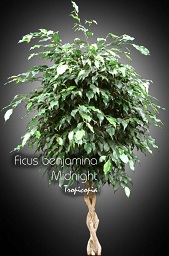Table of contents
Weeping fig

Latin Name: Ficus benjamina Midnight
Category: Ficus
Family: Moraceae
Origin: Cultivar
Climate: Tropical
Growing Zones: 11-9
Care Instructions
The Weeping fig (Ficus benjamina Midnight) is a tropical plant that originates from Cultivar. This ficus plant belongs to the Moraceae family and is well-suited for growing in USDA zones 11-9.
Complete Care Guide for Weeping Fig (Ficus benjamina Midnight)
Watering Requirements
The Weeping Fig, or Ficus benjamina Midnight, thrives best with a consistent watering schedule. It is essential to allow the top inch of soil to dry out between waterings. Overwatering can lead to root rot, so it’s crucial to ensure that the pot has adequate drainage. During the growing season (spring and summer), water the plant more frequently, approximately once a week, while in the dormant season (fall and winter), reduce watering to every two weeks. Always check the moisture level by inserting your finger into the soil; if it feels dry, it’s time to water. Additionally, using room temperature water is recommended to avoid shocking the plant.
Light Conditions
The Weeping Fig prefers bright, indirect light for optimal growth. While it can tolerate lower light conditions, insufficient light may lead to leaf drop and stunted growth. Ideally, place your Ficus benjamina Midnight near a window that receives filtered sunlight. Avoid direct sunlight, as it can scorch the leaves. If you notice the plant leaning towards the light source, it may be a sign that it needs to be rotated or moved to a brighter location. For indoor settings, consider using grow lights during the winter months when natural light is limited.
Soil Preferences
The Weeping Fig thrives in well-draining potting soil that retains some moisture without becoming soggy. A mix of peat moss, perlite, and pine bark works well to provide the necessary aeration and drainage. It is advisable to repot the plant every couple of years to refresh the soil and provide more space for growth. Fertilization should be done during the growing season with a balanced, water-soluble fertilizer every 4-6 weeks. In the dormant season, reduce or eliminate fertilization to allow the plant to rest.
Pests and Diseases
The Weeping Fig can be susceptible to common houseplant pests such as spider mites, aphids, and scale insects. Regularly inspect the leaves for any signs of infestation, such as webbing or sticky residue. If pests are detected, treat the plant with insecticidal soap or neem oil, ensuring to cover both the tops and undersides of the leaves. Additionally, the plant can suffer from leaf drop due to environmental stress, such as sudden changes in temperature or humidity. To prevent diseases, avoid overwatering and ensure good air circulation around the plant.
Special Care Tips
To maintain the health and beauty of your Weeping Fig, consider the following special care tips: First, regularly dust the leaves with a damp cloth to keep them clean and enhance photosynthesis. This also helps prevent pest infestations. Second, be mindful of temperature fluctuations; Ficus benjamina Midnight prefers temperatures between 60°F and 75°F (15°C to 24°C). Avoid placing the plant near drafts, heating vents, or air conditioning units. Lastly, if you notice the plant becoming leggy, you can prune it back to encourage bushier growth. Always use clean, sharp tools to make clean cuts and reduce the risk of disease.








